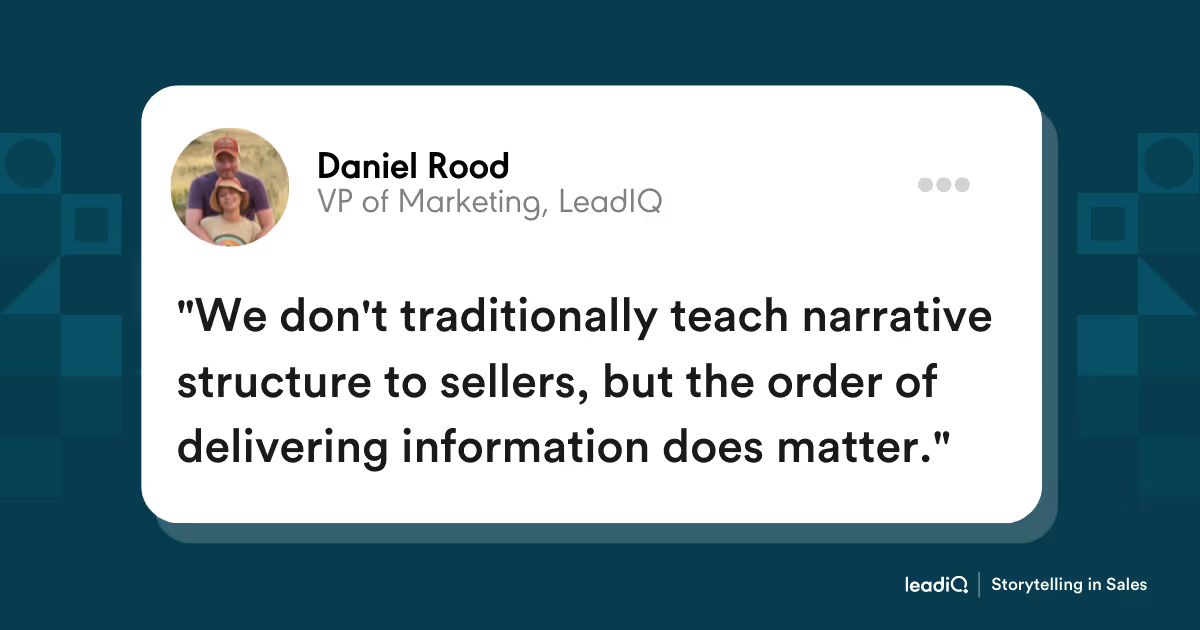Ready to create more pipeline?
Get a demo and discover why thousands of SDR and Sales teams trust LeadIQ to help them build pipeline confidently.





Get a demo and discover why thousands of SDR and Sales teams trust LeadIQ to help them build pipeline confidently.
A few weeks ago, I attended my daughter’s cross-country meet. I had 45 minutes to waste, so I walked into the school’s gymnasium to grab a water bottle from the concession stand. While walking back toward the starting line, I decided to take a shortcut through a beautiful new tennis complex on the school grounds when I was stopped in my tracks. I stopped because ahead of me, I saw death. Or at least that’s what I thought. A gravestone. On top of a concrete slab welcoming me to the tennis courts. The gravestone headline read, “Tennis Complex.”

My sadistic sense of humor kicked in at this well-intentioned yet wildly confusing message. My brain tried to make sense of what I was experiencing:
So confusing…
The intent and the delivery were all wrong. It was magically inappropriate and left the recipient confused and frustrated at the level of processing one had to do to make sense of it all.
As humans, we spend most of our time organizing information to make sense of the world. What’s important? What isn’t? It’s a mechanism of survival. This is never more true than at work. As employees, we are inundated with information every single day. We pay attention if the information is organized in a way that helps our brains understand quickly. If information is not organized, we throw it away.
Organized information is even more critical when it comes to creating a good story for your outbound sales messages. Every day I receive messages from eager sellers trying to break through the noise of my day to gain my attention. The same is true for you, right? Sellers try catchy sales pitches, headlines, attempts at connection through empathy, or pattern-breaking shock statements to peak my interestest and get that coveted reply.
But I’ve noticed that sellers rarely organize their value propositions in a compelling way that makes it easy for me to act. Here’s why I think that is…
We don’t traditionally teach narrative structure to sellers, but the order of delivering information DOES matter.
Therefore, like the memorial gravestone, the recipient is left confused and frustrated while completely ignoring the message.
I want to offer your sales team a few easy tips on organizing messages to make it easier for prospects to consume your value propositions in a way that might compel them to listen and take action.
The formula comes from storytelling. Movies, plays, and novels follow a formula to keep audiences engaged. You can use the same formula to engage your audience.

There are three characters in every story. They come in a specific order and have particular elements that make an audience compelled to pay attention. I’ll write more about all three in detail, but here is a quick summary.
Many sellers don’t understand that there is only room for one hero in a story, and it’s not you.
It’s the customer.
A prospective customer is on their own journey. Your job is to make them feel you are looking to help them transform based on that product you are selling. If you try to take your customer's place by presenting your product or service as the hero, you will lose your audience.
To have a compelling story, you have to introduce conflict. Many sales professionals miss this for fear of being too controversial. But great storytelling requires a good villain. Your customer is facing conflict and pain points in their hero journey. If you voice their conflict clearly, you can quickly grab their attention.
Here are two elements that you can use to make conflict make sense to your audience:
There is no story unless there is a Guide – the character who comes along to offer a solution to the Villian in a story. The Guide is YOU. Not the Hero. Not the Villian. But the Guide. This isn’t bad; the Guide is essential to help save the day. To be successful as a Guide, you’ll need to have three essential qualities:
If you want to avoid confusion and make your value proposition clear in your outbound prospecting, you could do worse than ensuring that your message is simple and clear so that your prospect understands their role as a Hero, their problem clearly labeled as the Villian, and your company’s role as a Guide.
Craft great stories, and your sales reps, and pipeline, will prosper.
Now let’s take a closer look at the hero of your story… your buyer »